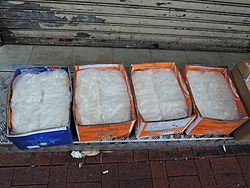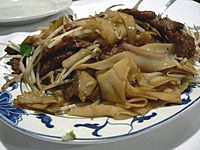Shahe fen facts for kids

A box of Shahe fen
|
|
| Alternative names | Ho fun, hofoen, hor fun, sar hor fun, kway teow, guotiao, da fen, guay tiew sen yai, kwetiau |
|---|---|
| Type | Chinese noodles |
| Place of origin | China |
| Region or state | Shahe District |
| Main ingredients | Rice |
| Variations | Kuyteav, hủ tiếu, kyay oh |
| Shahe fen | |||||||||||||||||||
|---|---|---|---|---|---|---|---|---|---|---|---|---|---|---|---|---|---|---|---|
| Chinese | 沙河粉 | ||||||||||||||||||
|
|||||||||||||||||||
| hefen | |||||||||||||||||||
| Chinese | 河粉 | ||||||||||||||||||
|
|||||||||||||||||||
Shahe fen (沙河粉), also known as he fen (河粉), is a popular type of wide Chinese noodle. These noodles are made from rice. You might also hear them called ho fun or hor fun. In places like Southeast Asia, they have other names such as kway teow or kwetiau.
Often, Shahe fen noodles are used in a dish called chao fen (炒粉). This dish is made by stir-frying the noodles with meat and vegetables. In North American Chinese restaurants, chao fen is usually known as chow fun.
Contents
What Are Shahe Fen Noodles?
Shahe fen noodles are white, broad, and a bit slippery. They have a bouncy, chewy texture. These noodles are best when bought fresh. They come in long strips or sheets that can be cut to any width you like. If fresh noodles aren't available, you can also find them dried in different widths.
Shahe fen noodles are quite similar to Vietnamese bánh phở noodles. It's thought that phở noodles came from their Chinese relatives. Wide phở noodles are often used in stir-fried dishes. Famous Thai dishes like phat si-io and drunken noodles also use similar wide noodles.
Different Names for Shahe Fen
The names shahe fen and he fen come from the Mandarin language. However, there are many other names based on Cantonese, like ho fun, hofoen, and hor fun.
Sometimes, shahe fen is also called kway teow (粿條). This name means "ricecake strips" and comes from Minnan Chinese. In Mandarin, it's called guotiao. You might know kway teow from dishes like char kway teow.
Even though they sound similar, shahe fen and kway teow are technically different. Hor fun (a type of shahe fen) is thin and absorbs sauces and flavors very well. This is because it has less starch. On the other hand, guotiao/kway teow is denser and doesn't absorb flavors as easily. It needs to be soaked longer when cooked.
In Sabah, these noodles are known as da fen (大粉). This means "wide vermicelli" because they look and feel similar to rice vermicelli. In Thailand, they are called guay tiew sen yai (เส้นใหญ่), meaning "large rice noodles." In Indonesia, they are called kwetiau, and in Vietnam, a similar version is called pho.
Where Shahe Fen Comes From

Shahe fen is believed to have started in a town called Shahe (沙河). This town is now part of the city of Guangzhou in southern Guangdong province, China. That's where the noodles get their name!
Shahe fen is a typical food in southern Chinese cooking. You can also find similar noodles in nearby Southeast Asian countries. These include Vietnam, Thailand, Cambodia, the Philippines, Malaysia, Indonesia, and Singapore. Many people of Chinese background live in these countries.
Chao Fen: A Popular Dish
Shahe fen noodles are often stir-fried with meat and vegetables. This dish is called chao fen (炒粉). The name chao fen comes from Mandarin Chinese. However, in Chinese restaurants in North America, this dish is usually called chow fun. This name comes from Cantonese.
Images for kids
See also
 In Spanish: Shahe fen para niños
In Spanish: Shahe fen para niños




